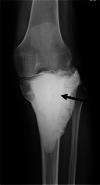Risk factors of fracture following curettage for bone giant cell tumors of the extremities
- PMID: 35590280
- PMCID: PMC9118605
- DOI: 10.1186/s12891-022-05447-x
Risk factors of fracture following curettage for bone giant cell tumors of the extremities
Abstract
Background: Following curettage of giant cell tumor of bone (GCTB), it is common to fill the cavity with polymethylmethacrylate (PMMA) bone cement, bone allograft, or artificial bone to maintain bone strength; however, there is a 2-14% risk of postoperative fractures. We conducted this retrospective study to clarify the risk factors for fractures after curettage for GCTB of the extremities.
Methods: This study included 284 patients with GCTBs of the extremities who underwent curettage at our institutions between 1980 and 2018 after excluding patients whose cavities were not filled with anything or who had additional plate fixation. The tumor cavity was filled with PMMA bone cement alone (n = 124), PMMA bone cement and bone allograft (n = 81), bone allograft alone (n = 63), or hydroxyapatite graft alone (n = 16).
Results: Fractures after curettage occurred in 10 (3.5%) patients, and the median time from the curettage to fracture was 3.5 months (interquartile range [IQR], 1.8-8.3 months). The median postoperative follow-up period was 86.5 months (IQR, 50.3-118.8 months). On univariate analysis, patients who had GCTB of the proximal or distal femur (1-year fracture-free survival, 92.5%; 95% confidence interval [CI]: 85.8-96.2) presented a higher risk for postoperative fracture than those who had GCTB at another site (100%; p = 0.0005). Patients with a pathological fracture at presentation (1-year fracture-free survival, 88.2%; 95% CI: 63.2-97.0) presented a higher risk for postoperative fracture than those without a pathological fracture at presentation (97.8%; 95% CI: 95.1-99.0; p = 0.048). Patients who received bone grafting (1-year fracture-free survival, 99.4%; 95% CI: 95.7-99.9) had a lower risk of postoperative fracture than those who did not receive bone grafting (94.4%; 95% CI: 88.7-97.3; p = 0.003).
Conclusions: For GCTBs of the femur, especially those with pathological fracture at presentation, bone grafting after curettage is recommended to reduce the risk of postoperative fracture. Additional plate fixation should be considered when curettage and cement filling without bone grafting are performed in patients with GCTB of the femur. This should be specially performed for those patients with a pathological fracture at presentation.
Keywords: Bone grafting; Cement; Curettage; Denosumab; Fracture; Giant cell tumor of bone.
© 2022. The Author(s).
Conflict of interest statement
The authors declare that they have no competing interests.
Figures









Similar articles
-
Supplemental Bone Grafting in Giant Cell Tumor of the Extremity Reduces Nononcologic Complications.Clin Orthop Relat Res. 2017 Mar;475(3):776-783. doi: 10.1007/s11999-016-4755-x. Clin Orthop Relat Res. 2017. PMID: 26932739 Free PMC article.
-
Similar local recurrence but better function with curettage versus resection for bone giant cell tumor and pathological fracture at presentation.J Surg Oncol. 2019 Jun;119(7):864-872. doi: 10.1002/jso.25391. Epub 2019 Feb 7. J Surg Oncol. 2019. PMID: 30734307
-
Soft tissue extension increases the risk of local recurrence after curettage with adjuvants for giant-cell tumor of the long bones.Acta Orthop. 2012 Aug;83(4):401-5. doi: 10.3109/17453674.2012.711193. Epub 2012 Aug 10. Acta Orthop. 2012. PMID: 22880716 Free PMC article.
-
The Role of Bone Grafting vs. Bone Cement in the Treatment of Giant Cell Tumor of Bone: A Systematic Review and Meta-Analysis on the Risk of Recurrence in 1,454 Patients.JBJS Rev. 2024 Sep 5;12(9). doi: 10.2106/JBJS.RVW.24.00080. eCollection 2024 Sep 1. JBJS Rev. 2024. PMID: 39236154
-
Current status of bone cementing and bone grafting for giant cell tumour of bone: a systemic review.Ann R Coll Surg Engl. 2019 Feb;101(2):79-85. doi: 10.1308/rcsann.2019.0004. Ann R Coll Surg Engl. 2019. PMID: 30688529 Free PMC article.
Cited by
-
Clinical Outcomes of Curettage versus Surgical Resection of Giant Cell Tumor of the Distal Radius - A Systematic Review and Meta-analysis.Rev Bras Ortop (Sao Paulo). 2024 Dec 21;59(6):e830-e838. doi: 10.1055/s-0044-1779321. eCollection 2024 Dec. Rev Bras Ortop (Sao Paulo). 2024. PMID: 39711646 Free PMC article.
-
Fixation with Carbon Fiber Plates After Curettage in Benign and Locally Aggressive Bone Tumors: Clinical and Radiographic Outcomes.J Clin Med. 2025 Mar 29;14(7):2371. doi: 10.3390/jcm14072371. J Clin Med. 2025. PMID: 40217820 Free PMC article.
-
The supercritical CO2 process does not affect the mechanical properties and the microarchitecture of trabecular bone at the microscopic scale: A microindentation and microcomputed tomography study.Bone Rep. 2025 Jul 25;26:101859. doi: 10.1016/j.bonr.2025.101859. eCollection 2025 Sep. Bone Rep. 2025. PMID: 40757247 Free PMC article.
-
Postoperative Fracture Risk in Giant Cell Tumor: A Case Report and Review of Literature.Cureus. 2023 Sep 29;15(9):e46192. doi: 10.7759/cureus.46192. eCollection 2023 Sep. Cureus. 2023. PMID: 37905245 Free PMC article.
-
Outcome of Reoperation for Local Recurrence Following En Bloc Resection for Bone Giant Cell Tumor of the Extremity.Curr Oncol. 2022 Sep 5;29(9):6383-6399. doi: 10.3390/curroncol29090503. Curr Oncol. 2022. PMID: 36135072 Free PMC article.
References
-
- Flanagan AM, Larousserie F, O’Donnell PG, Yoshida A. World Health Organ Classif Tumours Editorial Board. WHO classification of tumours. 5. Soft Tissue and Bone Tumours. Lyon: IARC; 2020. Giant cell tumour of bone; pp. 440–446.
-
- van der Heijden L, van de Sande MAJ, Heineken AC, Fiocco M, Nelissen RGHH, Dijkstra PDS. Mid-term outcome after curettage with polymethylmethacrylate for giant cell tumor around the knee: higher risk of radiographic osteoarthritis? J Bone Joint Surg Am. 2013;95:e159. doi: 10.2106/JBJS.M.00066. - DOI - PubMed
-
- van der Heijden L, van der Geest ICM, Schreuder HWB, van de Sande MAJ, Dijkstra PDS. Liquid nitrogen or phenolization for giant cell tumor of bone?: a comparative cohort study of various standard treatments at two tertiary referral centers. J Bone Joint Surg Am. 2014;96:e35. doi: 10.2106/JBJS.M.00516. - DOI - PubMed
-
- Uglialoro AD, Maceroli M, Beebe KS, Benevenia J, Patterson FR. Distal femur defects reconstructed with polymethylmethacrylate and internal fixation devices: a biomechanical study. Orthopedics. 2009;32 orthosupersite.com/view.asp?rID=41918. - PubMed
MeSH terms
Substances
LinkOut - more resources
Full Text Sources
Medical

